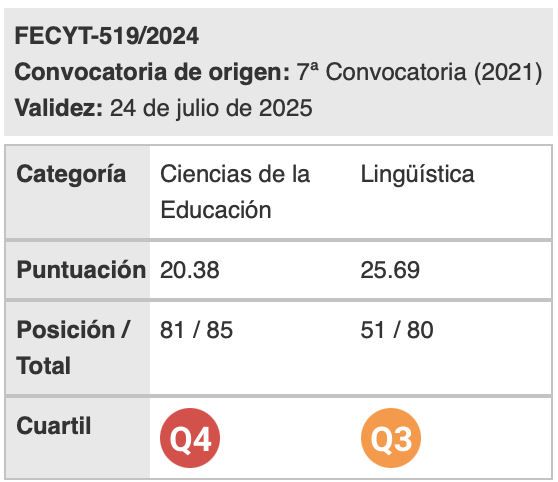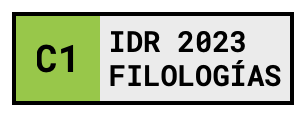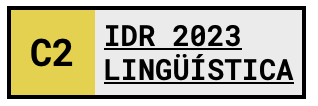Interdisciplinariedad y agresividad. Características del lenguaje de la fotografía en lengua inglesa
Palabras clave:
léxico, fotografía, lenguajes especializados, inglés para fines específicosResumen
El presente estudio aspira a explorar el lenguaje de la fotografía. En particular, pretende descubrir los principales rasgos léxico-semánticos del inglés de la fotografía. Se trata de un estudio de carácter cualitativo, basado en corpus de casi un millón de palabras cuyas fuentes han sido blogs sobre la fotografía, escritos por fotógrafos profesionales y nativos. Los resultados demuestran que se trata de un léxico de gran riqueza y variedad. Por una parte, destaca su carácter interdisciplinario; la fotografía no se limita a usar sus propias palabras, sino que comparte gran número de voces con otras disciplinas. Hemos localizado numerosos ejemplos de palabras heredadas del campo de la pintura, óptica, informática, entre otros. Por otra parte, hemos concluido que el lenguaje fotográfico presenta un carácter agresivo. Este estudio pretende contribuir por un lado al campo del Inglés para Fines Específicos, y, por el otro, a la fotografía, cuya importancia en la sociedad actual está creciendo.
Descargas
Citas
Alcaraz Varó, E. (2000). El inglés profesional y académico. Madrid: Alianza.
Alcaraz Varó, E. (2005). El lenguaje de la farmacia: lexicología y lexicografía. En F. Yus & J. Mateo Martínez (Eds.), Thistles: A homage to Brian Hughes (pp. 5-18). Alicante: Universidad de Alicante.
Alcaraz Varó, E., Campos, M.Á. & Miguélez, C. (2007). El Inglés Jurídico Norteamericano. Barcelona: Ariel.
Anthony, L. (2018). Introducing English for Specific Purposes. Abingdon, MA/Nueva York, NY: Routledge.
Belcher, D. (2006). English for Specific Purposes: Teaching to perceived needs and imagined futures in worlds of work, study, and everyday life. TESOL Quarterly, 40(1): 133-156.
Belcher, D. (Ed.) (2009a). English for Specific Purposes in theory and practice. Ann Arbor, MI: University of Michigan Press.
Belcher, D. (2009b). What ESP is and can be: An introduction. En D. Belcher (Ed.), English for Specific Purposes in Theory and Practice (pp. 1-20). Ann Arbor, MI: University of Michigan Press.
Bergh, G. & Ohlander, S. (2012). Free kicks, dribblers and WAGs. Exploring the language of the ‘people’s game’. Moderna språk, 106(1): 11-46.
Bergh, G. & Sölve, O. (2012). English direct loans in European football lexis. En V. Pulcini, F. Rodríguez González & C. Furiassi (Eds.), The Anglicization of European Lexis (pp. 281-304). Amsterdam: John Benjamins.
Biel, Ł., Engberg, J., Martín Ruano, R. & Sosoni, V. (Eds.), (2019). Research Methods in Legal Translation and Interpreting: Crossing Methodological Boundaries. Abingdon, MA/Nueva York, NY: Routledge.
Brown, J.D. (2016). Introducing needs analysis and English for Specific Purposes. Nueva York, NY/Londres: Routledge.
Cambridge Dictionary disponible en https://www.cambridge.org
Campos, M.Á. (2016). Increasing metaphor awareness in Legal English teaching. ESP Today, 4(2): 165-183.
Campos, M.Á. (2017). ‘Liaison magistrates’ and ‘contact points’ as a ‘remedy’ against ‘high levels of mistrust’: Metaphorical imagery in scholarly papers on EU judicial cooperation. Ibérica, 34: 231-255.
Campos, M.Á., Constantinescu, R., Erbeznik, A., Ferrara, C., Jannelli, L., Mazur, D., Petralikova, D., Samaniego Fernández, E., Walbaum Robinson, I.A. & Domuta, C. (2017). English for Human Rights EU Law. Bruselas: Comisión Europea.
Castellanos, P. (1999). Diccionario histórico de la fotografía. Madrid: Ediciones Istmo.
Castelo Sardina, L. (2001). Usos no normativos del lenguaje fotográfico. Tesis doctoral de la Universidad Complutense de Madrid.
Cohen, K. R. (2005). What does the photoblog want? Media, Culture & Society, 27(6), 883-901.
Dudley-Evans, T. & St John, M.J. (1998). Developments in English for Specific Purposes: A Multi-Disciplinary Approach. Cambridge: Cambridge University Press.
Ellis, M. & Johnson, C. (1994). Teaching Business English. Oxford: Oxford University Press.
Ferguson, G. (2013). English for Medical Purposes. En B. Paltridge y S. Starfield (Eds.), The Handbook of English for Specific Purposes (Vol. 120), (pp. 243-261). Oxford/Malden/Chichester: John Wiley & Sons.
Gállego Paz, R. (2002a). Notas sobre la historia del léxico de la fotografía en español. En M. T. Echenique & J. P. Sánchez Méndez (Eds.), Actas del V Congreso Internacional de Historia de la Lengua Española (pp. 2051-2062). Madrid: Gredos.
Gállego Paz, R. (2002b). El léxico técnico de la fotografía en español en el siglo XIX. Tesis Doctoral de la Universidad Rovira i Virgili.
Gállego Paz, R. (2003). El léxico de la fotografía en los textos del siglo XIX en España. Asclepio, 55(2), 135-158.
Garnelo Díez, M. I. (2005). La fotografía de creación: análisis de los fondos fotográficos de destacadas instituciones públicas y privadas de Andalucía. Tesis doctoral de la Universidad de Málaga.
Haigh, R. (2018). Legal English. Abingdon, MA/Nueva York, NY: Routledge.
Herschdorfer, N. (2015). The Thames & Hudson Dictionary of Photography. LondonLondres: Thames & Hudson.
Hutchinson, T. & Waters, A. (1987). English for Specific Purposes. Cambridge: Cambridge University Press.
Hyland, K. (2007). English for Specific Purposes. En J. Cummins & C. Davison (Eds.), (2007). International Handbook of English Language Teaching (pp. 391-402). Boston, MA: Springer.
Hyland, K. (2019). English for Specific Purposes: some influences and impacts. En X. Gao (Ed.), Second Handbook of English Language Teaching (pp. 337-353). Sídney: Springer.
Hyon, S. (2017). Introducing Genre and English for Specific Purposes. Londres: Routledge.
Jay, B. (1984). The photographer as aggressor. En A. Trachtenberg & D. Featherstone (Eds.), Observations: essays on documentary photography (pp. 7-23). San Francisco, CA: The Friends of Photography.
Johns, A.M. & Dudley‐Evans, T. (1991). English for Specific Purposes: International in scope, specific in purpose. TESOL Quarterly, 25(2), 297-314.
Johns, A.M., Paltridge, B. & Belcher, D. (2011). Introduction: New directions for ESP research. En D. Belcher, A.M. Johns & B. Paltridge (Eds.), New Directions in English for Specific Purposes Research (pp. 1-4). Ann Arbor, MI: University of Michigan Press.
Korstanje, M.E. (2010). Supremacy of English in tourism research. Anatolia, 21(2) 383-387.
Landau, P. (2002). Empires of the visual: Photography and colonial administration in Africa. En P. Landau & D. Kaspin (Eds.), Images and empires: Visuality in colonial and postcolonial Africa, (pp. 141-171). Los Angeles, CA: University of California Press.
Lynch-Johnt, B. & Perkins, M. (2008). Illustrated dictionary of photography: The professional’s guide to terms and techniques for film and digital imaging. Buffalo, NY: Amherst Media.
Merriam-Webster Dictionary disponible en <https://www.merriam-webster.com>
Mykytka, I. (2016). Metaphors in photography language. Ibérica: Revista de la Asociación Europea de Lenguas para Fines Específicos (AELFE), (32), 59-86.
Mykytka, I. (2017). The influence of English on the Spanish register of photography: An empirical study. ESP Today, 5(1), 68-90.
Navab, A. D. (2001). Re-picturing photography: A language in the making. Journal of Aesthetic Education, 35(1), 69-84.
Newhall, B. (2002). Historia de la fotografía [The history of photography from 1839 to the present], traducido por Homero Alsina Thevenet. Barcelona: Gustavo Gili.
Nickerson, C. & Planken, B. (2015). Introducing Business English. Nueva York, NY/Londres: Routledge.
Oshima, A., Hogue, A. & Lê, H.L. (2006). Writing Academic English, 4a ed. White Plains, NY: Longman.
Oxford English Dictionary disponible en <https://www.oed.com>
Paltridge, B. & Starfield, S. (2017). English for Specific Purposes. En E. Hinkel (Ed.), Handbook of Research in Second Language Teaching and Learning (Vol. 3), (pp. 56-67). Nueva York, NY/Londres: Routledge.
Paltridge, B. & Starfield, S. (Eds.) (2013). The Handbook of English for Specific Purposes (Vol. 120). Oxford/Malden/Chichester: John Wiley & Sons.
Peres, M. R. (Ed.). (2013). The focal encyclopedia of photography, 4a ed. Abingdon, MA/Burlington, VT: Taylor & Francis.
Pérez-Llantada, C. & Swales, J. (2017). English for Academic Purposes. En E. Hinkel (Ed.), Handbook of Research in Second Language Teaching and Learning (Vol. 3), (pp. 42- 55). Nueva York, NY/Londres: Routledge.
Pontrandolfo, G. (2016). Fraseología y lenguaje judicial. Las sentencias penales desde una perspectiva contrastiva. Roma: Aracne.
Robinson, P. (1991). ESP Today: A Practitioner’s Guide. Hemel Hempstead: Prentice Hall International.
Scarcella, R. (2003). Academic English: A conceptual framework. <https://escholarship.org/uc/item/6pd082d4> [15/04/2020]
Scharf, A. (1994). Arte y fotografía. Madrid: Alianza.
Sontag, S. (1977). On Photography. Nueva York, NY: Straus and Giroux Macmillan.
Soriano, T. (2012). El lenguaje de la fotografía. <https://www.tinosoriano.com/blog/2012/08/el-lenguaje-de-la-fotografia.html> [21/01/2020]
Starfield, S. (2016). English for Specific Purposes. En G. Hall (Ed.), The Routledge Handbook of English Language Teaching (pp. 150-164). Nueva York, NY/Londres: Routledge.
Stelzer, O. (1981). Arte y fotografía. Contactos, influencias y efectos [Kunst und photographie. Kontakte. Einflüsse. Wirkungen], traducido por Michael Faber-Kaise. Barcelona: Gustavo Gili.
Sutton, T. (1858). “A” dictionary of photography. Londres: Sampson Low.
Swales, J. (1985). Episodes in ESP. Oxford: Pergamon Press.
Swales, J. & Feak, C.B. (2004). Academic Writing for Graduate Students: Essential Tasks and Skills. Ann Arbor, MI: University of Michigan Press.
Szarkowski, J. (1978). Mirrors and windows: American photography since 1960. Nueva York, NY: Little Brown & Co.
Walker, R. & Harding, K. (2009). Oxford English for Careers: Tourism 1: Student's Book. Oxford: Oxford University Press.
Wilder, K. (2009a). Photography and the Art of Science. Visual Studies, 24(2),163-168.
Wilder, K. (2009b). Photography and Science. Londres: Reaktion Books.
Descargas
Publicado
Cómo citar
Número
Sección
Licencia
Aquellos autores/as que tengan publicaciones con esta revista, aceptan los términos siguientes:
- Los autores/as conservarán sus derechos de autor y garantizarán a la revista el derecho de primera publicación de su obra, el cuál estará simultáneamente sujeto a la Licencia de reconocimiento de Creative Commons que permite a terceros compartir la obra siempre que se indique su autor y su primera publicación esta revista.
- Los autores/as podrán adoptar otros acuerdos de licencia no exclusiva de distribución de la versión de la obra publicada (p. ej.: depositarla en un archivo telemático institucional o publicarla en un volumen monográfico) siempre que se indique la publicación inicial en esta revista.
- Se permite y recomienda a los autores/as difundir su obra a través de Internet (p. ej.: en archivos telemáticos institucionales o en su página web) antes y durante el proceso de envío, lo cual puede producir intercambios interesantes y aumentar las citas de la obra publicada. (Véase El efecto del acceso abierto).

Revista de Lenguas para fines específicos is licensed under a Creative Commons Reconocimiento-NoComercial-SinObraDerivada 4.0 Internacional License.























